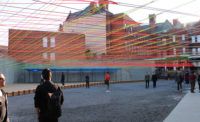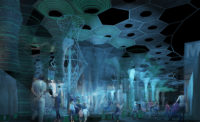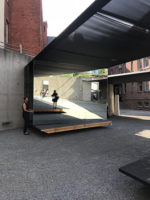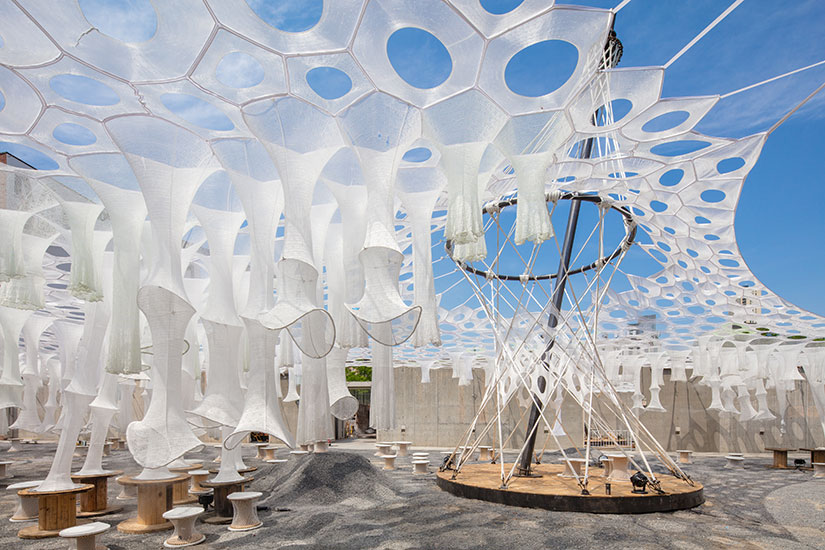2017 Young Architects Pavilion Now on View in MoMA PS1’s Courtyard

Photo © Jenny Sabin Studio

Photo © Jenny Sabin Studio

Photo © Jenny Sabin Studio

Photo © Jenny Sabin Studio

Photo © Jenny Sabin Studio

Photo © Jenny Sabin Studio

Photo © Jenny Sabin Studio

Photo © Jenny Sabin Studio

Photo © Jenny Sabin Studio

Photo © Jenny Sabin Studio

Photo © Jenny Sabin Studio

Photo © Jenny Sabin Studio












Last summer, Escobedo Soliz Studio's design for MoMA PS1’s Young Architects Program (YAP), Weaving the Courtyard, covered the Long Island City museum’s concrete-enclosed outdoor space with a minimalist canopy of crisscrossing neon ropes. This year’s installation, by Jenny Sabin Studio, takes weaving to another level: composed of over one million yards of robotically woven mesh, the temporary shelter, called Lumen, shifts color and emits a warm glow with the waxing and waning of the sun.
Lumen—which opened June 29—takes an intricately systematic approach to YAP’s usual requirement to provide shade, seating, and water for visitors. Whereas these elements were parsed out in Escobedo Soliz Studio’s design (wading pools were placed in corners; seating and shaded areas were arranged around the perimeter), Lumen’s design is decidedly connected. "I really thought about this operating as an environment," says Sabin. "The ideas of transformation, materiality, and adaptation were central when it came to generating the design."
The shading system’s core component is a synthetic fabric developed by Sabin—a 2016 recipient of RECORD’s Women in Architecture Awards—at her experimental design lab at Cornell University, where she is an assistant professor in the school of architecture. Originally prototyped for Nike, the material incorporates photo-luminescent and solar activated yarns that allow it to absorb, store, and produce light. This comes into full effect at dawn, when the entire structure becomes illuminated.
Over 1,500 individual disc-shaped components of the fiber were digitally knit and sewn together to form two canopies: one in the main courtyard, and another in an adjacent one. The larger one, in the primary space, incorporates 250 hanging fabric sleeves of various lengths; some nearly reach the ground, attaching to recycled plywood stools to form mini clusters of space, while others are left dangling, inviting visitors to feel the gauzy fabric. Built into these tubular forms is a sensor-based cooling system that discreetly releases mist when bodies are in close proximity.
Held up by two 43-foot-high steel-and-rope towers in the main space, and one 28-foot-high tower in the secondary space, the canopies are stretched from wall to wall. According to Sabin, finessing the tension to be just right proved to be one of the more challenging parts of the installation process, which took a little more than five weeks.
The platforms on which the towers stand serve as areas to gather; the one in the smaller yard functions as a ticket selling station for Warm Up, PS1’s weekly summer concert series — the primary consideration for the annual pavilion’s program. Over 100 spool stools, made from CNC-cut recycled plywood and robotically threaded with the special yarn, provide seating that can be picked up and moved around the courtyard.
Although translucent and punctured by holes, the netting is shadier than one might expect. "It really works," says Sabin, "It saved us from the intense sun on many afternoons during the installation period." On sunny days, its honeycomb-like pattern is projected as shadows on the ground and walls, an important thought for Sabin. During heavy rain, the canopies will droop slightly, but will pop back up within 30 minutes of drying.
Lumen encourages its visitors to become fully immersed in it, but one might wonder how something so gossamer in appearance—and so easy to reach out and touch—might survive the 10 beer-fueled Warm Up parties scheduled for this summer. Sabin seems only slightly worried: "It’s been engineered for people to potentially just hang on," she says, "but I really hope that doesn’t happen."
Lumen will be on view through September 4.
















